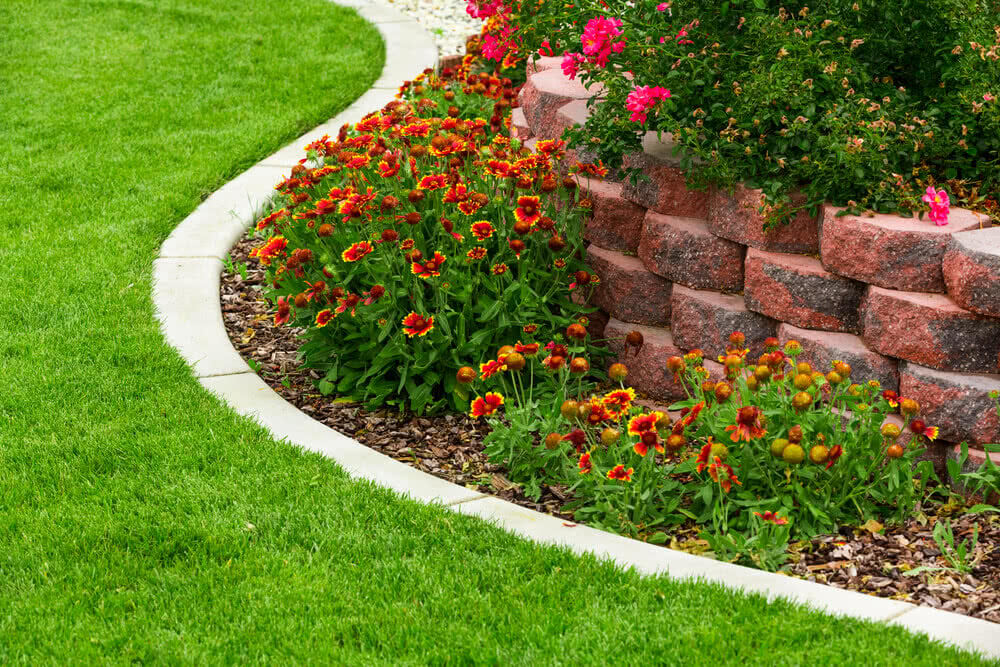Dwarf plants are generally used; but if water is scarce and the gardenbeds are not kept full of plants, an edging of neat tilesis ideal. In Pune, Ghar Edging is commonly seen.
Ghar Edging
Made of white crystalline stone, which is abundant on the low hills of the Deccan, called Ghar in Marathi, makes a beautiful edging when broken to display a new surface and neatly arranged. When fresh, its colour is too glaringly white if arranged in broad lines, but in short narrow lines, it looks neat.
Rules of Edging
- Edging should be proportionate to the width of the path and the size of the flower bed it demarcates. If distinct, it can scarcely be too small; 2-3 inches ‘in height is desirable for general purposes.
- Eight inches high is permissible as an edging to a wide road, but anything higher takes the character of a fence and appears out of place.
- Width is often a desirable feature; with Alternanthera cut down to three inches high, a width of fifteen to eighteen inches looks well.

Below are the plants for garden edging:
1. Alternanthera amabilis:
- This plant was introduced into gardens in Madras about 1870, and immediately took full possession of Indian gardens as an edging to the exclusion of nearly all other plants, and the mallees in Western India.
- On the side of a path fully exposed to the sun, no other plant is so easy to manage if water is abundant.
- This plant “ sports” freely; three distinct varieties have become fixed, and many more of less permanent character may be selected in any large garden.
- The typical Alternanthera amabilis has elliptical acuminate leaves varying in colour from green to bright crimson.
It has small spatulate leaves (increasing in width from the base upwards) and a dense growth habitat.

Alternanthera (amabilis) tricolour:
The plant features ovate leaves (like a longitudinal section of an egg) with a green margin, rose centre, and purple veins.

2. Justicia gendarussa (Jugut-Mudun):
- A dwarf plant with willow-like lance-shaped leaves, forms an excellent edging.
- Prefers heavy rainfall.
- Propagate by cuttings planted during the rains.
- Enjoys the shade, and when planted at the side of a wide road shaded with trees no edging looks better.
- Clip twice yearly.
- Keep 8 inches in height.

3. Pedilanthus Tithymaloides, Vilayti Sher:
- Commonly used as an edging.
- It has an advantage in growing in any garden soil that is open and friable.
- Requiring no watering after it is once established.
- A very prettily variegated variety was found at GaneshKhind in 1870; when it has become more plentiful, it will make a lovely edging.

4. Plumbago Capensis, Chitrak:
- This plant, by frequent clipping, may be brought into a dense form and is very well suited for edging wide roads.
- Propagate by cuttings of redwood.
- It thrives well as an edging at an altitude of over 2,000 feet above the sea.

5. The Miniature China Rose:
- It makes a beautiful edging, as it bears clipping well and flowers nearly all the year round.
- Any rich open soil well drained is suitable.
- Cuttings should be planted in a shady spot during the cold season and transplanted to their permanent quarters at the beginning of the rainy season if the rainfall is slight, or at the end if the fall is over 50 inches annually.
- If clipped twice yearly and regular attention is given to filling up blanks, this rose will make a neat edging about 8 inches high; therefore it is well suited for flower beds about twenty feet wide.

Ugaoo Tip: Smaller beds look better with a more little edging.
Source: Gardening in India by G.Marshall Woodrow










